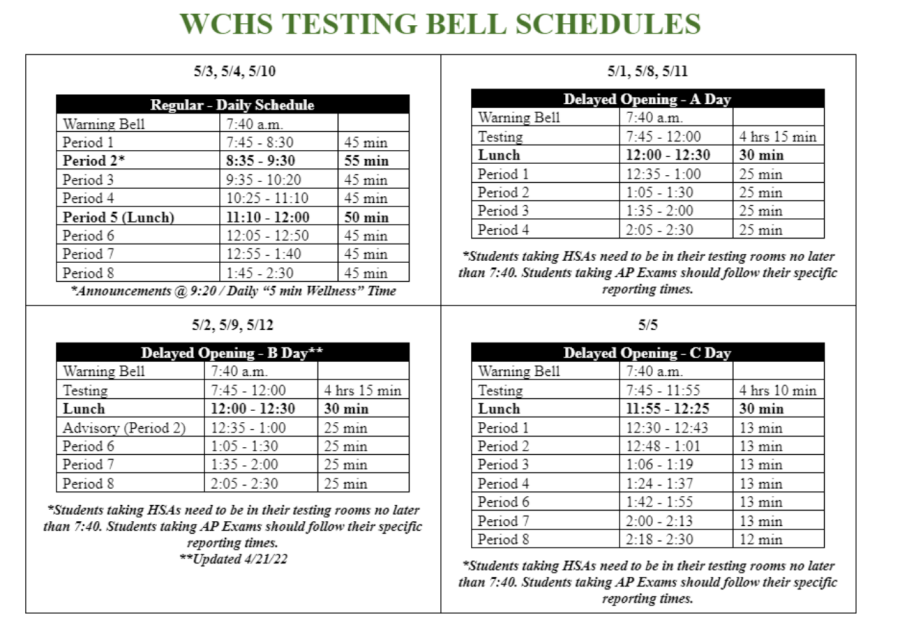Observer Opinion: Is a block schedule better?
June 8, 2023
More of these: well-paced classes, time to ask questions and in-class learning. Less of these: homework, wasted time and excessively required self-studying. Currently, the daily WCHS schedule suffers from this idealistic vision – many classes are overflowing with content and students can spend hours upon hours on their homework. Although there is not a single solution to these problems, switching to an A Day/B Day block schedule would be an extremely meaningful step in trying to do so.
In May, when both required state testing and AP exams happened simultaneously, WCHS launched its unexpected testing season class schedule. With class times that ranged from 13 to 25 minutes, it was thought of as a schedule that discouraged any practical learning during that time. However, many students found that it was a successful case study into something that should become the new normal: having fewer classes every day with more extended periods for each one while rotating between A and B days.
In other words, now that WCHS has firsthand experience with A/B block schedules, many have realized its previously unrealized benefits. Since most WCHS students experienced a similar seven-periods-a-day schedule in middle school, many had taken it for granted that this would continue in high school. The question to ask here, however, is should we really be emulating middle schools during high school?
According to the College Board, most college classes meet twice a week for an hour and 15 minutes each and can last for more than two hours. This is a long-standing nationwide statistic, which leads to the conclusion that this format must have meaningful benefits within advanced education. Additionally, if it is assumed that a priority of high schools is to prepare their students for higher education, having a class schedule that is a preview of what their direct learning-to-self-studying ratio will be in college can be a very important way of doing that.
When examining the reason behind colleges’ longer classes, the simple fact is that longer classes are more productive. Continuity is vital to effective learning, and not having to split up the learning of a topic over multiple days will help students to understand the material better quickly. Long classes will also allow for more in-depth assignments, more time for questions, and more one-on-one attention.
On top of that, this class structure would produce less homework for students and create more time for extracurricular activities. In today’s competitive college admissions process, pursuing these activities with particular dedication sets students apart. However, with shorter classes that require more learning outside of school hours, students’ ability to do this is impaired. Schools should be equipping their students to succeed outside of the classroom, not holding them back.
A third benefit of the block schedule would be that students could take at least one more class. Students can take seven classes a year, but if each block day were to have four or five classes, then this could change. For students who do not want to increase their workload, these additional periods could be used as study halls, which is still a productive use of time. This would be perfect for the many who would welcome the opportunity to expand their academic experience and are open to exploring their various interests in the classroom.
There is indeed opposition to the A/B schedule. One of the arguments given for having every class every day is that this is an application of the ‘spaced repetition’ learning method, which has been proven to be an effective way of learning. However, spaced repetition is only effective as a review technique after the content has been understood and learned; the short class periods of non-A/B schedules may prevent students from having that foundation established in the first place. Is it not a better use of class time for teachers to help students genuinely absorb the material, and then encourage the use of spaced repetition to supplement that with review? The logical conclusion is that yes, direct instruction time should be used to reduce the need for continuous self-teaching.
Thus, to maximize the student learning experience, WCHS must seriously consider whether or not the current schedule of seven short periods in a day is the most effective for students. In conclusion, an A/B Day schedule will better serve WCHS students in both the short and long term.



